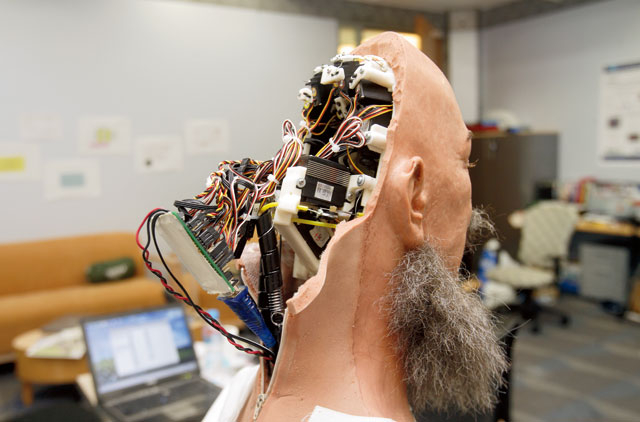
Images of robots I've seen jostle against each other in an attempt to categorise Ibn Sina, a humanlike robot dressed in a kandoora, bisht and ghutra, sitting on a stool.
There is Vicki, the android form of a ten-year-old girl from the American science fiction sitcom Small Wonder. Then from the movies, there is super-human cyborg ED 209 from Robocop; David from A.I. Artificial Intelligence who is programmed to love; Sonny from I-Robot with its faithfulness to humanity; and Andrew from Bicentennial Man who attempts to become more human.
But none of these images find common references in the human-like robot or android Ibn Sina, except when its creator exposes skeins of wires and circuits from under its traditional headgear. The electronic mishmash that springs out like unsightly entrails reveals its capability.
"What can Ibn Sina do?" I ask Dr Nikolaos Mavridis, the creator and assistant professor of Intelligent Systems at the United Arab Emirates University in Al Ain.
The Interactive Robots and Media Lab resembles a hybrid of diverse disciplines - an electronics repair store, a haberdashery, a studio and a camping site. There are shiny widgets, several pairs of shoes, motion capture cameras, and sleeping bags. Amidst all of this, Dr Mavridis says, "Let me show you."
The celluloid robots I've watched or heard of are capable of complex tasks ranging from multiple vision modes to emotions and even table tennis skills against a human. I wonder if the movies have skewed my perception of robots.
The demonstration involves a conversation with bilingual Ibn Sina.
"Do you speak Arabic?" I ask Dr Mavridis, whose native Greek accent isn't strong due to the years spent in the US where he completed his masters at the University of California Los Angles (UCLA) and PhD at the Massachusetts Institute of Technology (MIT).
"Enough to speak with him," he replies.
Dr Mavridis uses the pronoun ‘him' to refer to Ibn Sina. He proceeds to talk in Arabic, starting with the greeting, "Assalam alaikum [Peace be upon you]." Ibn Sina nods his head in acknowledgement and smiles, crinkling his eyes, to reply, "Wa aaikum assalam [and peace be upon you]."
"Look at the facial movement!" I remark.
Dr Mavridis asks, "Kaifa haaluka [how are you]?" And so continues the interaction between the animate and inanimate, covering topics from birthplace to popular Arabic poems.
"How did Ibn Sina do this?" I ask.
To find out, I have to revisit the time when Ibn Sina was still a rudimentary concept, which was three years ago.
Dr Mavridis was in the US. He agreed to relocate to the UAE because he was given carte blanche to set up an interactive robotics laboratory - the first of its kind in the region. He had a three-fold purpose: education, research, and outreach and cultural heritage.
"When I was at MIT, my main focus was robots and language," he says, explaining that androids are an ideal platform to inspire students and apply their learning regarding artificial intelligence [AI], robotics, vision and speech technologies.
He reified the concept of the world's first Arabic speaking android, modelling it on Ibn Sina, a highly respected philosopher and polymath. The philosopher was born in 980, and his work absorbed teachings of Aristotle, Galen and the knowledge of numerous cultures including Persian and Indian.
"If I had to name the android Aristotle, it wouldn't be as clearly connected to its people. The philosopher Ibn Sina [or Avicenna in the West] is well known in this region," he says.
The android in front of me, dressed in traditional attire, took almost two years to develop. Dr Mavridis led a team of undergraduates and research assistants. They combined face and speech recognition and other advanced artificial intelligence technologies. The objective was to design a unique interactive theatre installation around Ibn Sina to enable participation of humans and robots by merging sensor systems, tele-participation, robotic tele-presence and online virtual worlds.
He says, "The interactive theatre has achieved several goals, starting with bringing back the memory of the scholar Ibn Sina and of the time representing scientific and philosophical growth in the region. It has allowed students and researchers to play with different aspects of robotics. And perhaps even made people think about what it would be like to have a more varied ecology of beings - robots and other types of artificial intelligence interacting with humans."
So coming back to my question, "How did Ibn Sina respond?"
Dr Mavridis explains that the android has capabilities of facial expressions, hand gestures, speech recognition and synthesis in the Arabic language. It has 30 degrees "of freedom in its face", each resembling human musculature, to display emotions like happiness, sadness, disbelief and anger. It has another 25 degrees of freedom in its neck, arms, and fingers, enabling it to perform basic gestures.
"When people talk to Ibn Sina [in Arabic], it generates an appropriate response using speech recognition, corpus searching, speech synthesis, and expression and gesture generation" he says.
In other words, these technical components bridge the gap between Ibn Sina recognising speech and animating a response with facial expressions. Dr Mavridis says, "Various systems work to achieve this. To facilitate speech with the robot, we modelled a number of common sentences. We also experimented with the question of what kind of verbal stimuli you would need to update the emotional state of the machine."
As for Ibn Sina's face, Dr Mavridis worked with information in the form of the philosopher's miniatures and skull data. "Hanson Robotics [US-based developers of human-like robots with realistic facial expressions] used a specialised material called frubber to reconstruct his face. I concerned myself with the artificial intelligence and controls."
He adds, "One of the guidelines when creating a robot is to avoid it becoming too human because you create expectations for a lot of human-like behaviour that cannot be fulfilled. On the other hand, the advantages to getting more human-like is you can get more engagement."
As I move closer, I examine the wrinkles and worry lines, hinting at his age. "He is supposed to be about 60 years old," says Dr Mavridis.
"Has it sparked interest?" I ask him.
He replies, "Ibn Sina was at Gitex [Gulf Information Technology Exhibition] 2010. He was there in 2009 too. One pleasant difference between the first and the second time was there were more people who already knew about Ibn Sina. So far, he has travelled within the country for various exhibitions and to Saudi Arabia for the International Exhibition for Higher Education [IEHE]."
"How did people react to such technologies?"
In answer, Dr Mavridis talks about several experiments he and his team conducted, of which a few were published last year.
"We wanted to study attitudes and opinions of humans towards androids in this region. Our study found that Arabic attitudes are fairly positive overall. Respondents [a population sampling of 140 people], primarily from the UAE, but also from Iran, Iraq, Oman, Qatar, Saudi Arabia, and Yemen had significantly more favourable views than those from places like Egypt, Morocco, Tunisia, Libya, and Sudan. There is an overall higher acceptance rate here given that there is more exposure to new technology and more excitement."
The bugbears for Dr Mavridis and his team are shared by almost all other academic researchers in the UAE. He talks about lack of PhD students, research funding and general administrative support.
"However, there is a lot of potential for the country and especially in the region in terms of technological breakthroughs," he says. "There must be a wider realisation of the societal benefits of academic research in today's global high tech economy."
I ask, "How do you see Ibn Sina and robotic technology become part of our everyday lives?"
He replies, "As mentioned, the current practical benefits include data on human-robot interaction, giving my students a platform to conduct research, and exposure for the university and the country.
"In the future, I can see at least three real-world applications for Ibn Sina - a museum, shopping mall and reception robot."
"What do you think is the future of artificial intelligence?" I ask.
Dr Mavridis says, "I am a little more positive regarding the future of AI because right now we have a deeper theoretical understanding of what we mean by the word intelligence. We also have access to more data sets - through the internet and crowdsourcing - towards our quest to give a device the experience that a ten-year-old human might have. We also use the whole human body to communicate with machines through motion control systems [example: Microsoft Kinect].
"We have a much bigger bandwidth of communication and richer engagement with a machine, so to speak, more so if it answers and behaves in an anthropomorphic manner."
I ask him if he thinks the movies influence our understanding of robots.
He pauses and then sighs. "It is a fact of life. Because of the movies, there are notions that have been formed to what you expect from a robot. We have to consider this when we design one. But as always, there is a lot of free space for innovation beyond current imagination."
By the way …
- Speaking to Ibn Sina is a good way to improve your accent because if you don't speak correctly, the android won't recognise your speech, according to Dr Mavridis.
- The Arabic spoken by Ibn Sina is close to the Khaleeji dialect.
- The speech recognition component used in Ibn Sina is based on the Acapela speech recognition engine.













